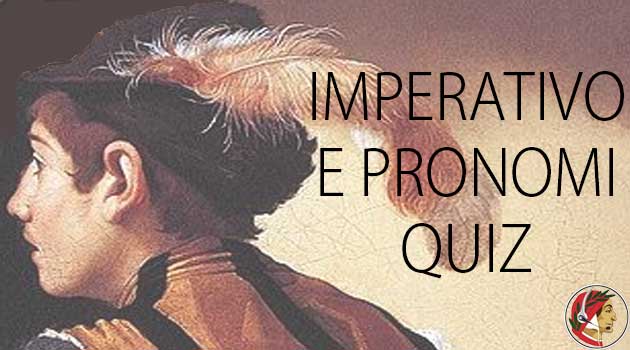We can combine the imperativo with pronouns in a single word. Learn the most common scenarios and solve the quiz at the bottom of this post.
LEVEL: Intermediate.
I recently wrote a post about the Italian imperativo with simple audio examples. I
| IMPERATIVO | parlare | correre | aprire | finire |
|---|---|---|---|---|
| tu | parla | corri | apri | finisci |
| noi | parliamo | corriamo | apriamo | finiamo |
| voi | parlate | correte | aprite | finite |
| tu (negativo) | non parlare | non correre | non aprire | non finire |
So, the imperativo, or giving orders in Italian, is basically very similar to the presente indicativo, (with the exception of -ARE –> (TU) PARLA instead of (TU) PARLI).
The negative imperativo of NOI & VOI is NON + IMPERATIVO. Non parlate.
The negative imperativo of TU is NON + infinitive= Non parlare, “don’t speak”.
Conjugations with the imperative are quite limited, since we can give orders only to TU, NOI and VOI. We can combine the imperativo with any pronouns – direct object, indirect object, CI & NE – as follows:
- Prendi il telefono –> PRENDILO
- Finisci i compiti –> FINISCILI
- Dai i soldi a Lucia –> DAGLIELI
- Regala la bicicletta a Dario –> REGALAGLIELA
- Aiutiamo le tue amiche –> AIUTIAMOLE
- Dite a Francesca di venire –> DITEGLIELO
- Compra le sigarette per me –> COMPRAMELE
- Porta i bambini al cinema –> PORTACELI
- Assaggia una fetta di torta –> ASSAGGIANE UNA FETTA
In some of the examples above, we can see how direct and indirect pronouns merge together with the imperativo to create a single word . e.g DAGLIELI.
The following verbs can have an irregular imperative with TU.
| andare | dare | dire | fare | stare | |
| TU | vai (va’) | dai (da’) | di’ | fai (fa’) | sati (sta’) |
When combined with some pronouns there’s a duplication of consonants. For example:
- Vai al mercato –> VACCI
- Dai a me i soldi –> DAMMI I SOLDI –> DAMMELI
- Dai a me le chiiavi –> DAMMI LE CHIAVI –>DAMMELE
- Di’ a noi cosa pensi –> DICCI COSA PENSI –> DICCELO
- Fai il tuo lavoro –> FALLO
- Fai a noi un piacere –> FACCI UN PIACERE –>FACCELO
- Stai a casa –> STACCI
The negative imperative with TU is NON + INFINITO. The infinito has the same property of the imperativo. It can be combined with pronouns. Alternatively, we can put the pronoun before the verb. For example:
- Non salutare Luigi –> Non salutarlo = Non lo salutare.
- Non bere la birra –> Non berla = Non la bere.
- Non comprare la moto a Davide –> Non comprargliela = Non gliela comprare.
- Non dare i soldi a loro –> Non darglieli –> Non glieli dare.
LEI & LORO
The imperativo of the formal tu = Lei and Loro is in fact a form of congiuntivo presente. Pronouns do not merge with the verbs.
LEI
- Vada a casa –> Ci vada.
- Mi saluti Suo marito –> Me lo saluti.
- Prenda il mio ombrello –> Lo prenda.
LORO
- Vadano a casa –> Ci vadano.
- Bevano tutti del vino –> Ne bevano tutti.
- Prendano il treno –> Lo prendano.
Thanks for reading. Please read more in the quiz. Alla prossima!
Quiz-summary
0 of 5 questions completed
Questions:
- 1
- 2
- 3
- 4
- 5
Information
LOADING QUIZ...
You have already completed the quiz before. Hence you can not start it again.
Quiz is loading...
You must sign in or sign up to start the quiz.
You have to finish following quiz, to start this quiz:
Results
Time has elapsed
Your score is 0 out of 0 points, (0)
| Average score |
|
| Your score |
|
Categories
- Not categorized 0%
- 1
- 2
- 3
- 4
- 5
- Answered
- Review
-
Question 1 of 5
1. Question
Drag & Drop
Combine situations and the appropriate imperativo of the verb prendere.
e.g. Vuoi una birra --> Prendila
Sort elements
- Prendiamole
- Prendetela
- Prendilo
- Lo prenda
- prendetele
-
Vogliamo delle patatine.
-
Volete una macchina nuova.
-
Vuoi un gelato
-
Signora, vuole un caffè?
-
Volete le vostre valigie
Correct
In red, your errors.
✅ Check your answers↓↓↓
Incorrect
In red, your errors.
✅ Check your answers↓↓↓
-
Question 2 of 5
2. Question
Drag & Drop
Combine situations and the appropriate imperativo of the verbs DIREor DARE.
Devi dire a Mario di venire ---> Diglielo
Sort elements
- Diciamoglielo
- Dagliele
- Glielo dica
- Glielo dia
- Dammela
- Diamoglielo
-
Dobbiamo dire a Stefano di aspettarci.
-
Devi dare le chiavi a mio padre.
-
Signora, deve dire ai suoi figli di studiare.
-
Signor Rossi, deve dare il telefono a sua moglie.
-
Devi dare a me la tua bicicletta.
-
Dobbiamo dare il regalo ad Anna.
Correct
In red, your errors.
✅ Check your answers↓↓↓
Incorrect
In red, your errors.
✅ Check your answers↓↓↓
-
Question 3 of 5
3. Question
Drag and Drop
Same rules, now you have 7 random situations. Match the right imperativo.
Sort elements
- daglielo
- stacci
- faccelo
- raccontacele
- raccontategliela
- stateci
- parlatene
-
Devi dare un'aiuto a Claudio.
-
Vuoi stare in spiaggia tutto il giorno.
-
Devi fare un massaggio a noi.
-
Vuoi raccontare a noi le tue vacanze.
-
Volete raccontare alla polizia la vostra storia.
-
Dovete stare in ufficio fino a tardi.
-
Volete parlare di vostro figlio.
Correct
In red, your errors.
✅ Check your answers↓↓↓
Incorrect
In red, your errors.
✅ Check your answers↓↓↓
-
Question 4 of 5
4. Question
Dovete comprare il vino rosso
e bevete poco vino rosso.

Make it simple with the imperativo, select the right sentence.
Correct
Compratelo e bevetene poco.
✅ Check your answers↓↓↓
Incorrect
Compratelo e bevetene poco.
✅ Check your answers↓↓↓
-
Question 5 of 5
5. Question
Dovete comprare una macchina fotografica
e dovete dare questa macchina a Cesare.
 Correct
Correct
Compratela e dategliela.
✅ Check your answers↓↓↓
Incorrect
Compratela e dategliela.
✅ Check your answers↓↓↓


